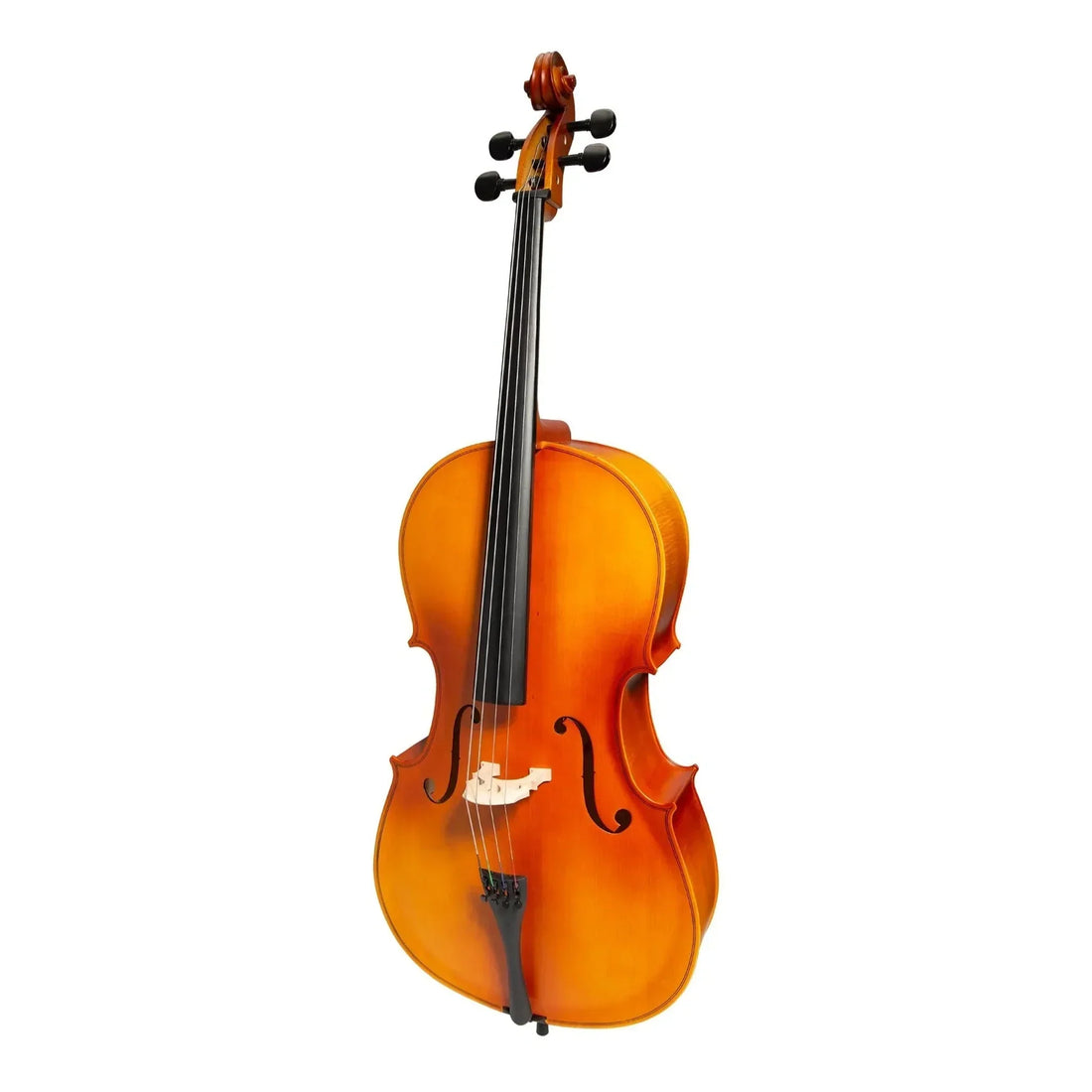The cello, with its deep, resonant voice and expressive capabilities, holds a central position in orchestral, chamber, and solo classical music. Its rich timbre, akin to the human voice, makes it a captivating instrument for both performers and listeners.
This guide, developed by Joondalup Music Centre in Perth, offers a comprehensive overview of cellos, addressing crucial considerations for musicians at all levels, from those embarking on their first lessons to seasoned professionals. We will delve into the intricacies of construction materials, explore popular brands and models, discuss the nuances of sound quality, outline essential maintenance protocols, and examine the cost implications associated with instruments across different proficiency levels.
Construction Materials: The Heart of the Cello's Resonance
The materials used in a cello's construction are paramount to its tonal quality, durability, and aesthetic appeal. The selection and craftsmanship of these woods dictate much of the instrument's character.
Top Plate (Soundboard):
- Typically crafted from spruce, specifically tonewood spruce (e.g., European spruce or Engelmann spruce). Spruce is chosen for its excellent resonant properties, high strength-to-weight ratio, and ability to transmit vibrations effectively. The grain pattern and age of the spruce heavily influence the cello's responsiveness and clarity of tone.
Back, Sides, and Neck:
- Predominantly made from maple, often flamed maple for higher-grade instruments due to its attractive wavy grain. Maple contributes to the cello's projection, brightness, and the speed of its response. The density and cut of the maple significantly impact the instrument's overtone characteristics.
Fingerboard and Pegs:
- Ebony is the preferred material for the fingerboard, pegs, and sometimes the tailpiece and chin rest. Ebony is an exceptionally dense, hard, and durable wood, resistant to wear from strings and fingers. Its stability helps maintain tuning and prevents warping.
Varnish:
- The varnish is not merely aesthetic; it plays a critical role in the cello's acoustic properties.
- Oil Varnish: Often associated with older, master-crafted instruments, oil varnishes are applied in thin layers, allowing the wood to vibrate more freely, contributing to a warm, rich, and complex tone.
- Spirit Varnish: Dries more quickly and can be applied in a thicker layer. While offering good protection, some argue it can slightly impede the wood's natural resonance compared to a fine oil varnish.
Fittings:
- The tailpiece, chin rest (though less common on cello, the equivalent is the endpin), and endpin are also important. These are often made from ebony, rosewood, or modern composite materials, influencing the instrument's balance and sustain. The endpin, supporting the cello on the floor, can be made of carbon fibre or steel, affecting vibration transfer.
Popular Cello Brands & Models: A Journey Through Craftsmanship
The cello market offers a broad spectrum of instruments, ranging from mass-produced student models to meticulously handcrafted master instruments.
Beginner Cellos:
- Brands like Stentor, Steinhoff, and Valencia are popular choices for beginners. These instruments are typically made from laminated woods or solid woods with simpler construction, prioritising durability, affordability, and ease of playability for students. They provide a solid foundation for developing fundamental techniques and understanding the instrument.
Intermediate Cellos:
- Intermediate players often opt for cellos from brands such as Eastman (e.g., VC305, VC405), Gliga (e.g., Gama series), and Scott Cao (e.g., STC017E). These instruments feature higher-grade solid tonewoods, more refined craftsmanship, and better quality fittings. They offer improved tonal depth, projection, and responsiveness, allowing for greater musical expression and suitability for advanced student orchestras or serious amateur playing.
Professional Cellos:
- Professional cellists typically gravitate towards instruments from renowned contemporary luthiers, or historical instruments from acclaimed makers such as Stradivari, Guarneri, or Amati. For modern professional-grade instruments, brands like Eastman (Master series, e.g., Andreas Eastman, Samuel Eastman), Jay Haide (e.g., L’Ancienne), and select European makers produce exceptional cellos. These instruments are meticulously crafted from premium, aged tonewoods, featuring precise graduations, superior varnishes, and the finest fittings. They exhibit outstanding tonal complexity, projection, resonance, and playability, meeting the demands of concert performances and professional recordings.
Sound Quality: Crafting the Cello's Voice
The cello's rich sound quality is a complex interplay of its construction, setup, and the player's technique.
- Resonance and Projection: The quality of the tonewoods and the precise "graduation" (thickness variation) of the top and back plates are critical for the cello's resonance and ability to project sound effectively.
- Tone Colour (Timbre): A high-quality cello offers a wide palette of tone colours, from warm and mellow lows to bright and singing highs. This is influenced by the wood, varnish, and overall setup.
- Responsiveness: A good cello should respond easily and quickly to the bow, allowing for nuanced dynamics and articulation.
- Balance Across Strings: The sound should be even and balanced across all four strings, with no "wolf tones" (undesirable sympathetic vibrations).
- Luthier Setup: Even a well-made cello requires an expert luthier's setup (adjusting the bridge, soundpost, nut, and string height) to achieve its optimal sound and playability.
Maintenance Protocols: Preserving Your Cello's Integrity
Proper maintenance is crucial for preserving the tonal quality, structural integrity, and longevity of a cello.
- Daily Cleaning: After each use, wipe down the strings, fingerboard, and body (especially under the bridge) with a soft, lint-free cloth to remove rosin dust and fingerprints.
- String Care: Strings should be wiped clean after playing and replaced periodically, typically every 6-12 months, depending on usage and string type. Old strings can dampen the sound.
- Bow Maintenance: The bow hair should be rehaired every 6-12 months, as it loses its grip and elasticity. Rosin should be applied sparingly.
- Bridge and Soundpost: The bridge should be checked regularly for proper alignment and curvature. The soundpost, a small wooden dowel inside the cello, should only be adjusted by a luthier.
- Environmental Control: Cellos are sensitive to changes in humidity and temperature. Store the instrument in its case when not in use, ideally in a humidity-controlled environment (40% to 60% relative humidity) to prevent cracking or warping of the wood.
- Professional Servicing: Regular inspections and adjustments by a qualified luthier (e.g., annually) are essential for addressing any potential issues, optimising the setup, and performing necessary repairs.
Cost Considerations: Investing in Musical Expression
The cost of a cello varies significantly based on its quality, craftsmanship, and materials.
Beginner Cellos: Typically range from $500 to $1,500. These are factory-made, durable, and include basic components, often sold as outfits with a bow and case.
Intermediate Cellos: Featuring better quality tonewoods, more refined craftsmanship, and improved fittings, these range from $1,500 to $5,000. They offer a noticeable step up in sound and playability.
Professional Cellos: These instruments start from $5,000 and can reach upwards of $20,000, with master instruments by renowned luthiers (historical or contemporary) potentially costing hundreds of thousands. They represent a significant investment in musical excellence.
Accessories: Factor in the cost of essential accessories, which can be substantial:
- Bow: Ranges from $50 for student bows to thousands for professional bows.
- Case: Ranges from $100 for soft cases to $1,000+ for lightweight, protective hard cases.
- Strings: A full set of quality strings can cost $100-$300+.
- Rosin, Endpin Stop, Humidifier.
Maintenance: Budget for regular luthier servicing and repairs, which are ongoing costs.
Key Features:
- Crafted from resonant tonewoods like spruce (top) and maple (back/sides/neck).
- Ebony fingerboard and quality fittings ensure durability and playability.
- Brands cater to all skill levels, from student outfits to master-grade instruments.
- Sound quality is influenced by wood, varnish, precise setup, and player technique.
- Requires consistent maintenance, including cleaning, string care, and humidity control.
- Cost varies significantly, reflecting the craftsmanship and quality of materials.
FAQ:
Q: What is the ideal humidity level for storing a cello?
A: The ideal relative humidity for storing a cello is between 40% and 60% to prevent cracking or warping of the wood.
Q: How often should I change my cello strings?
A: Cello strings should typically be changed every 6 to 12 months, depending on how frequently you play and the type of strings you use, as they lose their resonance over time.
Q: Can a beginner start directly on a full-size cello?
A: Most beginners start on a full-size cello if they are old enough, but younger students may begin on fractional sizes (e.g., 1/4, 1/2, 3/4) based on their height and arm length.
Q: What is the purpose of the soundpost in a cello?
A: The soundpost is a small wooden dowel inside the cello that transmits vibrations between the top and back plates, significantly affecting the instrument's tone, balance, and projection.
Q: Do more expensive cellos always sound better?
A: Generally, yes, as more expensive cellos use higher-grade, aged tonewoods and superior craftsmanship, which contribute to a richer, more complex, and resonant sound. However, proper setup and player skill are also crucial.

